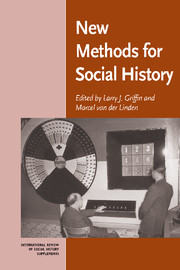Book contents
- Frontmatter
- Contents
- NOTES ON CONTRIBUTORS
- Introduction
- Temporally Recursive Regression and Social Historical Inquiry: An Example of Cross-Movement Militancy Spillover
- Using Event History Analysis in Historical Research: With Illustrations from a Study of the Passage of Women's Protective Legislation
- Incorporating Space into Social Histories: How Spatial Processes Operate and How We Observe Them
- Narrative as Data: Linguistic and Statistical Tools for the Quantitative Study of Historical Events
- The Logic of Qualitative Comparative Analysis
- Historical Social Network Analysis
- Historical Inference and Event-Structure Analysis
Historical Inference and Event-Structure Analysis
Published online by Cambridge University Press: 04 August 2010
- Frontmatter
- Contents
- NOTES ON CONTRIBUTORS
- Introduction
- Temporally Recursive Regression and Social Historical Inquiry: An Example of Cross-Movement Militancy Spillover
- Using Event History Analysis in Historical Research: With Illustrations from a Study of the Passage of Women's Protective Legislation
- Incorporating Space into Social Histories: How Spatial Processes Operate and How We Observe Them
- Narrative as Data: Linguistic and Statistical Tools for the Quantitative Study of Historical Events
- The Logic of Qualitative Comparative Analysis
- Historical Social Network Analysis
- Historical Inference and Event-Structure Analysis
Summary
INTRODUCTION
Event-structure analysis (ESA) is a member of a family of formal analytic procedures designed to analyze and interpret text, in particular the temporal sequences constituting the narrative of a historical event. Its basic purpose is to aid the analyst in “unpacking” an event – that is, in breaking it into constituent parts - and analytically reconstituting it as a causal interpretation of what happened and why it happened as it did. ESA focuses on and exploits an event's “narrativity” – its temporal orderliness, connectedness and unfolding – thereby helping historians and social scientists infer causal links between actions in an event, identify its contingencies and follow their consequences, and explore its myriad sequential patterns. Unlike most other formal analytical techniques, it is completely nonnumeric and non-statistical: ESA's value is largely heuristic and centered on how it relentlessly probes the analyst's construction, comprehension and interpretation of the event.
More firmly and self-consciously than do most formal analytical procedures, ESA partially bridges the often damaging methodological chasm separating narrative history and generalizing social science. On the one hand, it borrows from formal social science methodology several features, including
(a) explicit deployment of theoretical concepts and hypotheses about social life;
(b) application, development and validation of causal generalizations;
(c) use of replicable procedures of analysis.
By forcing the user to be meticulous in the construction of narratives, to reason causally about unfolding temporal sequences, and to be clear about the bases of causal and interpretive judgements, ESA lays bare the investigator's understanding so starkly – literally, as will be seen, as a diagram of the logic of action – that insights into causal connectedness and significance are intensely sharpened.
- Type
- Chapter
- Information
- New Methods for Social History , pp. 145 - 165Publisher: Cambridge University PressPrint publication year: 1999



